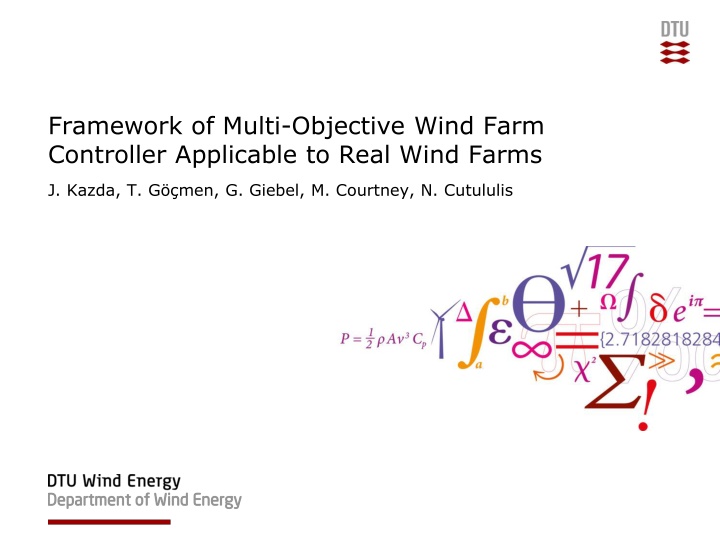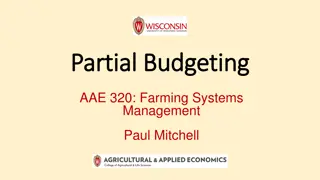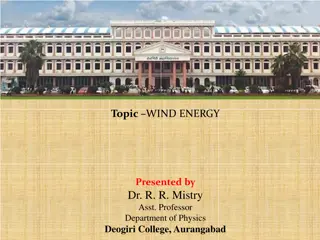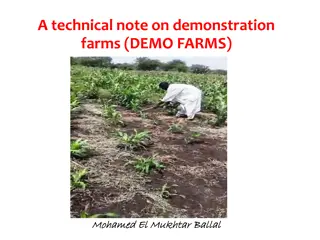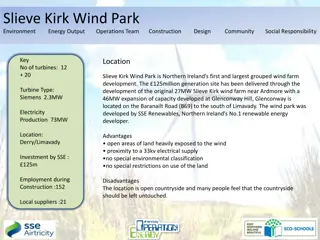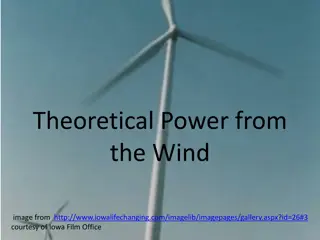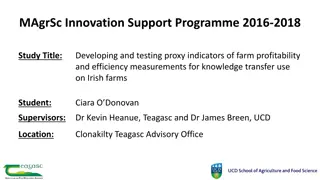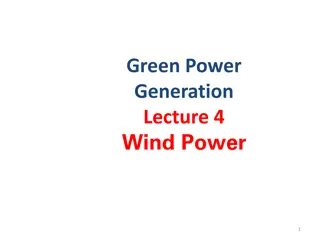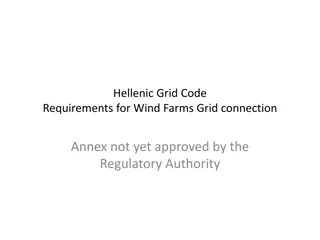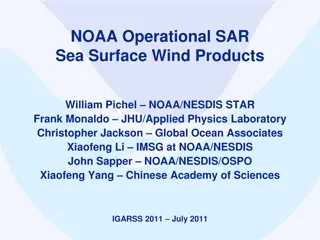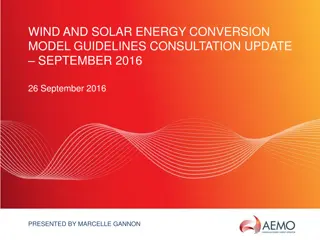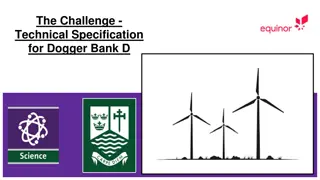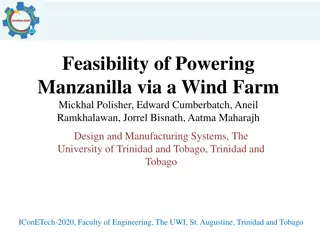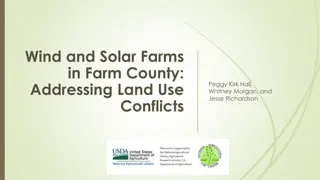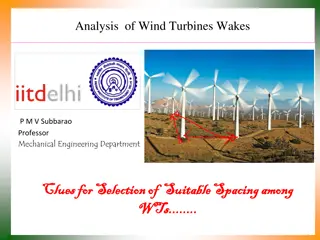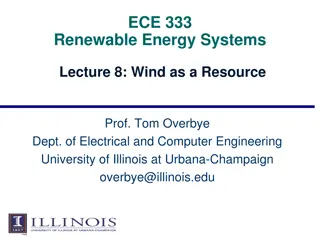Optimal Wind Farm Control Framework for Real Wind Farms
This research focuses on developing a framework for a multi-objective wind farm controller applicable to real wind farms. It addresses the significant power loss and increased fatigue loads caused by wake effects in wind farms. The objectives include composing solutions into a control framework, identifying critical research areas in optimal wind farm control, and outlining a methodological framework that optimizes the farm's performance in all operation modes. The study emphasizes the importance of validated and advanced wind farm operation models to enhance the efficiency of wind farm control strategies.
Uploaded on Sep 14, 2024 | 6 Views
Download Presentation

Please find below an Image/Link to download the presentation.
The content on the website is provided AS IS for your information and personal use only. It may not be sold, licensed, or shared on other websites without obtaining consent from the author.If you encounter any issues during the download, it is possible that the publisher has removed the file from their server.
You are allowed to download the files provided on this website for personal or commercial use, subject to the condition that they are used lawfully. All files are the property of their respective owners.
The content on the website is provided AS IS for your information and personal use only. It may not be sold, licensed, or shared on other websites without obtaining consent from the author.
E N D
Presentation Transcript
Framework of Multi-Objective Wind Farm Controller Applicable to Real Wind Farms J. Kazda, T. G men, G. Giebel, M. Courtney, N. Cutululis
Motivation Wake effects cause up to 40% power loss and 80% increased fatigue loads in wind farms1 Optimal wind farm control (WFC) can potentially mitigate adverse wake effects2 Image source: Christopher Steiness Various optimal wind farm control approaches proposed in literature WFC Present wind farms do not use such control strategies Operation set-point 1 Sanderse, B. (2009). Aerodynamics of Wind Turbine Wakes: Literature Review. Energy Research Center of the Netherlands (ECN), ECN-E 09-016, Petten, The Netherlands, Tech. Rep, 46. 2 S. Barth, E. T. G. Bot, and H. B. Hendriks, Evaluation of Heat and Flux Farm Control, Tech. Report. ECN-E-07-105, ECN, 2007. 2 DTU Wind Energy, Technical University of Denmark 14-Sep-24
Objectives Compose solutions into control framework Identify critical research areas in optimal WFC Provide solutions Outline methodological framework of optimal wind farm controller that incorporates these solutions is applicable to real wind farms optimises the farm s performance in all operation modes 3 DTU Wind Energy, Technical University of Denmark 14-Sep-24
Overview of Optimisation Approaches in Optimal Wind Farm Control Model-based optimal WFCs are composed of optimisation approach wind farm operation model Commonly used optimisation objectives are maximisation of stationary total wind farm power output following of total power reference and reduction of turbine fatigue loading Optimisation algorithms are extensively discussed in literature. These are non-linear optimisation techniques algorithms for linearized models such as linear quadratic control 4 DTU Wind Energy, Technical University of Denmark 14-Sep-24
Validated, Advanced Wind Farm Operation Models Required Present optimal WFC use wind farm operation models that are validated, static models originally derived for wind farm planning often extended for use in WFC, however seldomly validated estimate turbine fatigue loads using static loads Future models should be validated experimentally include more environmental parameters such as turbulence intensity consider dynamics of wind farm operation such as wake meandering and fatigue loads Overall, optimisation approaches need to consider relevant phenomena of dynamic wind farm operation 5 DTU Wind Energy, Technical University of Denmark 14-Sep-24
Validated, Advanced Wind Farm Operation Models Used in Present Work Wind farm controller in present work shall use validated, advanced models Wind turbine loads are modelled based on HAWC2 tool HAWC2 is aeroelastic wind turbine simulation tool widely used in industry SCADA-based estimation of wind farm power curve using PossPOW PossPOW is experimentally validated tool for real-time estimation of total wind farm power Validation performed both for normal and for downregulated operation of wind farm Estimate of wind farm power based on SCADA data 6 DTU Wind Energy, Technical University of Denmark 14-Sep-24
Optimal WFC Designed as Add-on to Existing Infrastructure Software architecture is aligned with communication norm of wind farm control Active power controller of existing WFC WFC add-on Wind farm active power operation mode Optimised turbine operation set-points HAWC2-based turbine load model Sensor data PossPOW Tool Other information Other control 7 DTU Wind Energy, Technical University of Denmark 14-Sep-24
Optimised Performance in All Wind Farm Operation Modes Normal operation Balancing services Delta control Power maximisation Balance control operation mode Active power Abs. power limit Power rate limit Actual Base line Operation change Available power calculation using PossPOW objective WFC Total power maximisation Power reference following with fatigue minimization 8 DTU Wind Energy, Technical University of Denmark 14-Sep-24
Flexible Software Architecture Provides Design Adaptability Modular structure allows for easy adaptation of wind farm controller to different operator objectives and wind farm technology Optimisation algorithm Wind farm controller Wind farm model Measurement post- processing 9 DTU Wind Energy, Technical University of Denmark 14-Sep-24
Summary Controller add-on optimises wind farm performance in all wind farm operation modes with respect to total power turbine fatigue loading Wind farm operation model shall use validated, advanced models, i.e. PossPOW and HAWC2-based turbine model Norm compliant, modular design of wind farm controller add-on allows easy applicability to real wind farms 10 DTU Wind Energy, Technical University of Denmark 14-Sep-24
Future Work Testing of WFC using numerical wind farm simulation tools possibly full-scale wind farm Vattenfall & Hasager, Charlotte Bay, et al. "Wind farm wake: The Horns Rev photo case." Energies 6.2 (2013): 696-716. 11 DTU Wind Energy, Technical University of Denmark 14-Sep-24
DTU Wind Energy at WindEurope Summit 2016: Stand 574, Hall B6 Events @ WindEnergy Hamburg Day 2: Materials Research Wednesday 28 September 2016 Events @ WindEnergy Hamburg Day 3: Applications Thursday 29 September 2016 Events @ WindEnergy Hamburg Day 1: Teaching and Learning Tuesday 27 September 2016 Morning Morning Morning 11:00-11:15 Non-destructive materials characterization in 3D by S ren F ster 11:00-11:15 New Extreme wind method in WAsP Engineering 4 by Xiaoli Guo Lars n 11:00-11:15 A new flexible and affordable WAsP self-study course by Niels G. Mortensen Presentation incl. demonstration. Discuss with scientists afterwards. Discuss with scientists afterwards. Presentation incl. demonstration. Discuss with scientists and teachers afterwards. Afternoon Afternoon Afternoon 14:00-14:15 myWindTurbine.com wind for every rural household on earth by Andreas Bechmann 14:00-14:15 Non-destructive materials characterization in 3D by S ren F ster 14:00-14:15 Wind energy courses at university level by Merete Badger Presentation incl. demonstration. Discuss with scientists afterwards. Hands on session too. Discuss with scientists afterwards. Presentation incl. demonstration. Discuss with scientists and teachers afterwards. 12 DTU Wind Energy, Technical University of Denmark 14-Sep-24
